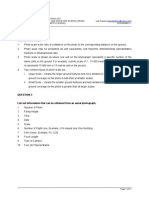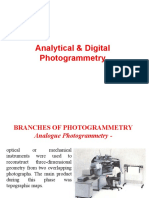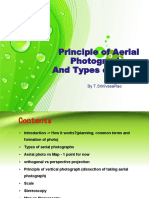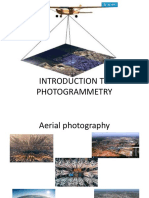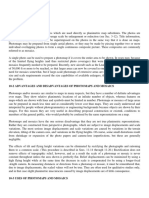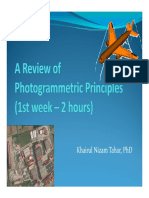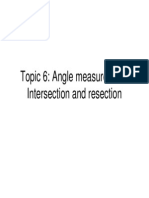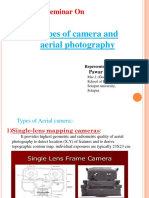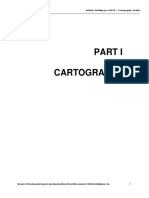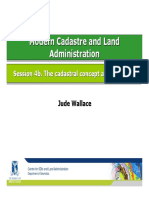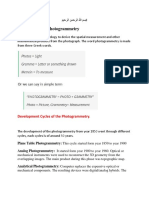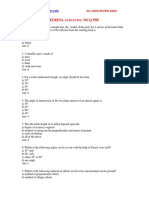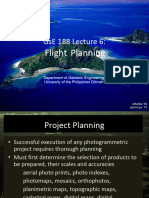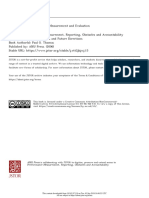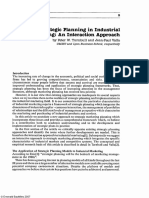Flight Planning
Flight Planning
Uploaded by
Praveen MeenaCopyright:
Available Formats
Flight Planning
Flight Planning
Uploaded by
Praveen MeenaOriginal Description:
Copyright
Available Formats
Share this document
Did you find this document useful?
Is this content inappropriate?
Copyright:
Available Formats
Flight Planning
Flight Planning
Uploaded by
Praveen MeenaCopyright:
Available Formats
Flight Planning
Presented by-
Praveen Meena
14520012
Geomatics engineering,
M.Tech 1
st
year
What is flight planning ?
It is one of the three basic phases of planning for a photogrammetric project.
Three phases of planning a photogrammetric project are:-
1. development of a flight plan.
2. planning the ground control and executing necessary field surveys- for
accuracy requirement of the project.
3. estimation the cost involved in the project.
To produce a map of the desired accuracy.
Finding out the best fit flight lines and camera exposure stations to cover the
project area with minimum number of models, flight lines and camera
exposure stations.
Basic elements in flight planning:-
The flying height above a datum.
The ground distance between successive exposures.
The ground spacing between the flight lines.
Why we need flight planning in
photogrammetry?
To ensure coverage of the area to be mapped at the required scale with no gaps,
and provide stereo models by an efficient design.
A flight plan will determine the spacing between successive photographs,
location of flight lines and other details.
This entails the preparation of detailed instructions for the plane-camera crew
regarding the location of the pictures, the flight strips, and the area to be flown.
This is also important for a safety flight , reducing aerial survey operational
costs, and speeding up the preparation and execution of the photo missions and
flight.
Flight planning or flight design depends
on the following factors:-
The intended use of the photography:-
Mosaic, land-use study etc.
Map compilation using stereo plotting equipment.
The exact boundaries of the project.
The nature, extent, and location of existing control.
The type of terrain.
Factors for plannig the flight map:-
Purpose of the photography
The ground distance between successive exposures
Ground spacing of between the flight lines
Flying height above a datum , usually sea level
Photographic scale
Allowable scale variation
Relief displacement
Photographic Tilt
Crab and drift
Direction or orientation of the topography or terrain
Steps for flight planning:-
Determining of the project requirements.
Considering the requirements of the project , project area, photo scale, end lap,
side lap, direction of strips, coordinate system, camera type, and film type are
determined.
According to these data, base distance between two exposure stations along
flight line and the distance between two adjacent flight strips are calculated.
The flight height is calculated for each strip by checking the terrain height of
related strip.
After that, coordinates of exposure stations are obtained.
Purpose of the photography:
Wide or normal camera types are selected according to
characteristics of the project area.
Wide length cameras (f= 152mm) are preferred for the area that is
smooth.
In order to obtain a favorable base height ratio that enhances vertical
accuracy.
Super-wide angle (f=88mm) camera:- if the topography is very flat.
Normal lens (f=210mm) cameras are preferred for the area that is
hilly or urban area. eg. Forest area..
It will also determine the %age of overlap and sidelap.
Photo scale:-
Varies with the project.
Scale =
=
It affects the map accuracy and area
configuration.
Longer the f, the larger the scale,
assuming a constant flight height.
The scale of a vertical aerial photograph is inversely proportional to the
quantity (H-h), i.e. high altitude photographs are normally small scale.
Scale not only differs from photograph to photograph and strip to strip but also
the average scale can differ somewhat from what is intended.
Photo scale is selected depending on the project purposes, such as the desired
accuracy of final product, purpose of use etc.
The smallest possible photo scale is selected because of reducing the number of
models.
End lap and side lap:-
Overlap :- the overlap in the along the line of sight is called forward overlap,
or simply overlap.
In order to obtain stereo model, end lap is assumed to be 60 %.
To cover the project area completely with stereo models along the strips,
side lap is assumed to be 30 % of the width of the photograph.
if the terrain is fairly rugged, both overlap and sidelap should be increased.
Allowable scale variation:-
Scale variation in a photograph or between photographs is
caused by variation in the ground elevation, by a variation in
flying height, or by both.
Variations caused by difference in ground elevation and
flying height.
Longer focal length reduces the scale variation.
Flying height:-
Height above the datum.
Factors affecting the flying height:-
Desired scale, relief displacement, and relief.
Precision of scale used
Greater precision, greater possible flying height, and that will
also increase the ground coverage per photography four times.
More the flying height, greater the area covered, and thus less ground
control and fewer photos required.
C-factor =
( precision factor)
from which,
Flying height = (contour interval) X (C- factor)
WHY CONTOUR INTERVAL ?
Because vertical accuracy in a topographic map is the liming factor in
photogrammetry.
The C factor is understood to be that value which will produce photography
satisfactory to obtain the desired vertical accuracy In the map.
C factor take ib values anywhere from 750 to 2500 ( mostly 2200)
For a given system, its value will depend on the conditions surrounding the
entire map-compilation operation.
Relief displacement:-
It affects the construction of mosaics.
it is a characteristic of aerial images over varied terrain.
Objects that rises above the surface lean away from the principal point.
Objects extending below the surface lean towards the principal point.
Relief displacement increases with the height of the object and/or distance
from the principal point.
It will decrease as the flying height is increased.
Also, to maintain a certain scale as the flight height is increased, the focal
length must be increased.
and =
=
( )
and R =
Relief distortion =
()
=
RD is radial from nadir point regardless of
unintentional or accidental tilt of the camera. This
is a fundamental concept of photography.
The effect of tilt:-
Two component:-
1. the amount in the direction of flight, called y-tilt, or angle .
2. the amount in the direction of the flight line, called x-tilt or angle .
y tilt will cause increase or decrease in overlap between successive
photographs.
X tilt will cause the sidelap to increase on one side of the flight line and to
decrease on the opposite side.
Causes of tilt-
The absence of stable horizontal reference plane during flight.
Human error in holding the camera in the only available reference plane.
Air turbulence.
The effect of y tilt on overlap must be allowed for by decreasing
the computed exposure interval slightly to produce a slight
increase in the theoretically desired overlap
The effect of x tilt on sidelap must be allowed for by decreasing
the computed spacing between flight lines slightly to produce a
slight increase in the desired sidelap.
Crab
crab is the angle formed between the flight line and the edges of the photograph
in the direction of flight.
it will reduce the effective width of coverage of the photography .
it is caused by not having the focal plane of the camera squared with the
direction of flight at the instant of exposure.
It can be corrected by the rotation of camera about the vertical axis of the
camera mount.
Drift
It is caused by the failure of the aircraft to stay on the predetermined flight
line.
It will cause in loss of sidelap on the side
opposite the direction of drift.
It will cause gapping in between adjacent
flight lines.
Computation of flight plan:-
Data required to compute different quantities for flight
planning of an area are:-
1. focal length of the camera lens
2. flying height above a stated datum.
3. Size of photograph.
4. Size of area to be photographed.
5. Position of the outer flight lines with respect to the boundary of the area.
6. Overlap.
7. Sidelap.
8. Scale of flight map.
9. Ground speed of aircraft.
Problem:- An area that is 15 miles long in the north south direction,
and 8.5 miles wide in the east west direction is to be
photographed with a lens having a 12-in. focal length for the
purpose of constructing a mosaic. The photograph size is 9 by 9
in. The average scale is to be 1:12,000 effective at an average
elevation of 700 ft above sea level. Overlap is to be at least 60%
and sidelap is to be at least 35%. An intervalometer will be used
to control the interval between exposures. The ground speed of
the aircraft will be maintained at 150 mph. The flight lines are to
be laid out in a north south direction on an existing map having
an scale of 1:62,500. The two outer flight lines are to coincide
with the east and west boundaries of the area. Determine the data
for the fight plan.
FIG. Calculation of flight plan
Flying height:-
we know that scale = focal length / flying height
i.e.
1
(700)
=
1
12000
So, H= 12,700 ft above sea level.
Ground distance between flying lines:-
the ground spacing, W=
5.85 . 12,000
12 ./
= 5850
Number of flight lines:-
Width of the area = 8.5 miles X 5280 ft/mile = 44,880 ft.
Required number of flight lines = number of spacings + 1
=
44,880
5850
+1 = 9
Adjacent ground distance between flight lines:-
Wa =
44,880
91
= 5610
the sidelap will be slightly greater than 35%
Spacing of flight lines on flight map:-
Wm =
5610
62,500
12
= 1.08
Ground distance between exposures:-
since 60% overlap is there, the net gain per photograph = 0.40 x 9 in. = 3.60 in.
The corresponding ground distance is,
B =
3.60 12,000
12 .
= 3600 .
Exposure interval:-
Speed of aircraft = 150 mph =
150 5280
60 60
= 220 ft/s
The required exposure interval is,
I =
3600
220 /
= 16.4 s or 16 seconds
Adjusted ground distance between exposures:-
for the adjacent exposure interval, the ground distance is,
Ba= 220 ft/s X 16 s = 3520 ft
Number of photographs per unit flight line:-
total length of a flight line = 15 miles X 5280 ft/mile = 79,200 ft.
lets make allowance for two extra exposures at each end of each strip,
the number of photographs per flight lines is,
79,200
3520
+4 = 26.5 or 27 photos/flight line
Hence entire photography will require, 9 X 27 = 243 photographs.
Hence,
Number of photographs required = 243 photographs
Flight lines spacing on map = 1.08 inch
Exposure interval = 16 seconds
It will ensure the required overlap of 60 %.
THANK YOU
You might also like
- Final Exam 2014-QuestionDocument2 pagesFinal Exam 2014-QuestionPannhaa100% (2)
- Assignment - 7Document4 pagesAssignment - 7Chea Masangkay100% (3)
- Chapter 1 - Triangulation and TrilaterationDocument21 pagesChapter 1 - Triangulation and TrilaterationABAMELANo ratings yet
- 1 Analytical Photogrammetry Lecture 1Document22 pages1 Analytical Photogrammetry Lecture 1amalinaah71% (7)
- TOPOGRAPHIC SURVEYING PROCEDURE by R.T.K - EnglishDocument15 pagesTOPOGRAPHIC SURVEYING PROCEDURE by R.T.K - EnglishSein Win Oo100% (2)
- @updated+cadastral Surveying NotesDocument88 pages@updated+cadastral Surveying NotesCollins Kipchabas100% (6)
- PRACTICE PROBLEMS in PhotogrammetryDocument10 pagesPRACTICE PROBLEMS in PhotogrammetryIan Val Pahac100% (5)
- Photogrammetry Mathematics 080116Document128 pagesPhotogrammetry Mathematics 080116firosekhan100% (2)
- SUG541 - Advanced Photogrammetry - 17 QuestionsDocument11 pagesSUG541 - Advanced Photogrammetry - 17 Questionsmruzainimf91% (11)
- Analytical & Digital PhotogrammetryDocument46 pagesAnalytical & Digital PhotogrammetryLuis Marquez Guillen100% (3)
- Surveying QuestionsDocument24 pagesSurveying QuestionsPetForest Ni Johann100% (1)
- Geodetic Surveying PDF NotesDocument2 pagesGeodetic Surveying PDF NotesRichard Bryan100% (6)
- Chapter 4-Analytical Photogrammetry PDFDocument3 pagesChapter 4-Analytical Photogrammetry PDFKarungi Arone0% (1)
- Power Electronics DW Hart McGraw-Hill 2010 BBS 123Document5 pagesPower Electronics DW Hart McGraw-Hill 2010 BBS 123paul kioiNo ratings yet
- James Keating Book Review of Tinkering Toward Utopia: A Century of Public Education Reform by Tyack & CubanDocument11 pagesJames Keating Book Review of Tinkering Toward Utopia: A Century of Public Education Reform by Tyack & CubanCeitinn LibraryNo ratings yet
- Flight Planning For Aerial PhotographyDocument5 pagesFlight Planning For Aerial PhotographyMichael Mutale100% (1)
- Photogrammetry Flight PlanningDocument27 pagesPhotogrammetry Flight PlanningJoseph Dincht67% (3)
- Aerial TriangulationDocument37 pagesAerial TriangulationRussel Clarete100% (1)
- Flight Planning & AP CalculationDocument17 pagesFlight Planning & AP CalculationSaurabh Suman100% (1)
- Photogrammetry QADocument21 pagesPhotogrammetry QAVyle SabadoNo ratings yet
- Chapter One PPT of GeodesyDocument31 pagesChapter One PPT of GeodesyGemechu Kotola100% (3)
- CHAPTER 2 Contro SurveyDocument49 pagesCHAPTER 2 Contro Surveyaduyekirkosu1scribdNo ratings yet
- 3.lecture - 2 Type of Areal PhotgraphDocument34 pages3.lecture - 2 Type of Areal PhotgraphFen Ta HunNo ratings yet
- Analytical Photogrammetry: Principles of Aerial Triangulation and Concepts of Bundle AdjustmentDocument12 pagesAnalytical Photogrammetry: Principles of Aerial Triangulation and Concepts of Bundle AdjustmentJoshi ChumbaleNo ratings yet
- Aerial Photogrammetry: Presented by Scholar NoDocument34 pagesAerial Photogrammetry: Presented by Scholar Norajat pandeyNo ratings yet
- Priciple of Aerial Photography and TypesDocument42 pagesPriciple of Aerial Photography and TypesTOt's Vin67% (3)
- 1 GLS455 Introduction To Photogrammetry Prof WanDocument46 pages1 GLS455 Introduction To Photogrammetry Prof Wansharonlly toumas100% (1)
- Stereoscopic Restitution Instruments: Materi Kuliah GD3204 Fotogrametri I, Semester I-2009/2010Document50 pagesStereoscopic Restitution Instruments: Materi Kuliah GD3204 Fotogrametri I, Semester I-2009/2010ththaalNo ratings yet
- 29 June 2020 - Introducing Photogrammetric Concepts Dr. Poonam S. TiwariDocument45 pages29 June 2020 - Introducing Photogrammetric Concepts Dr. Poonam S. TiwariLiamNo ratings yet
- Photomaps and PhotomosaicsDocument14 pagesPhotomaps and PhotomosaicsKumar kumarapu100% (5)
- Remote SensingDocument50 pagesRemote SensingVisalakshi Venkat50% (2)
- A Review of Photogrammetric PrinciplesDocument72 pagesA Review of Photogrammetric PrinciplesAna NadhirahNo ratings yet
- Selected Topics in Geodesy Part 2Document53 pagesSelected Topics in Geodesy Part 2Osama SherifNo ratings yet
- Introduction To Photogrammetry and Air Survey: BY Assistant Professor Nasrul HaqDocument43 pagesIntroduction To Photogrammetry and Air Survey: BY Assistant Professor Nasrul HaqAsad Chattha100% (1)
- PhotogrammetryDocument33 pagesPhotogrammetryfirosekhan100% (1)
- Definition of Geodetic Surveying. PPTDocument17 pagesDefinition of Geodetic Surveying. PPTAhmad SalimNo ratings yet
- Aerial Cameras, Aerial Films, and Film ProcessingDocument14 pagesAerial Cameras, Aerial Films, and Film ProcessingPedro MendoncaNo ratings yet
- Computer Application in Land SurveyingDocument14 pagesComputer Application in Land Surveyingsunny92% (24)
- GEODESY Review Exam No AnswerkeyDocument4 pagesGEODESY Review Exam No AnswerkeyMichael Densing Inso67% (3)
- Surveying McqsDocument15 pagesSurveying Mcqsbrotherkh26No ratings yet
- Method of Determining Scale of Aerial PhotographyDocument3 pagesMethod of Determining Scale of Aerial PhotographyRashidi Maokola100% (1)
- Angle Measurement: Intersection and ResectionDocument23 pagesAngle Measurement: Intersection and ResectionHoney SinghNo ratings yet
- Photogrammetry and Remote SensingDocument14 pagesPhotogrammetry and Remote SensingJoseph Dincht83% (6)
- Tutorial PhotogrammetryDocument2 pagesTutorial PhotogrammetryAyush P GuptaNo ratings yet
- Seminar On: Types of Camera and Aerial PhotographyDocument10 pagesSeminar On: Types of Camera and Aerial PhotographyJahanara BegumNo ratings yet
- CartoDocument59 pagesCartoRhea CelzoNo ratings yet
- 04-The Cadastral Concept and EvolutionDocument36 pages04-The Cadastral Concept and EvolutionEldynandTrissandiTyawarmanNo ratings yet
- Introduction To Photogrammetry: Development Cycles of The PhotogrammetryDocument8 pagesIntroduction To Photogrammetry: Development Cycles of The PhotogrammetryEng Abdulahi HajiNo ratings yet
- Survey Lecture Notes 3Document1 pageSurvey Lecture Notes 3mogijo11dffdfgdfgNo ratings yet
- Photogrammetry 21.10.2022Document33 pagesPhotogrammetry 21.10.2022Guru MurthyNo ratings yet
- Volume CalculationsDocument11 pagesVolume CalculationsAhmad KhaledNo ratings yet
- Triangulation and TrilaterationDocument21 pagesTriangulation and TrilaterationQne DanielNo ratings yet
- Photogrammetry PDFDocument11 pagesPhotogrammetry PDFPaul Carlos Seguil HuamanNo ratings yet
- CartoDocument6 pagesCartoBeltran KathNo ratings yet
- Surveying MCQsDocument17 pagesSurveying MCQsShahbaz Ak100% (3)
- Survey MCQ'S PDFDocument14 pagesSurvey MCQ'S PDFPavan Ps86% (7)
- Model Exam For Exit - Second - ODB - UniDocument25 pagesModel Exam For Exit - Second - ODB - Uniy4494964100% (3)
- 2013 Cadastral Surveying - Test 1 (MEMO) PDFDocument5 pages2013 Cadastral Surveying - Test 1 (MEMO) PDFbillsNo ratings yet
- L9 Photogrammetry PDFDocument33 pagesL9 Photogrammetry PDFAinur NasuhaNo ratings yet
- Lecture 6 (Flight Planning)Document40 pagesLecture 6 (Flight Planning)Bill Dominique BuljatinNo ratings yet
- Aerial PhotographyDocument56 pagesAerial PhotographyRajan TiwariNo ratings yet
- Photogrammetry PDFDocument8 pagesPhotogrammetry PDFArham SheikhNo ratings yet
- SOP of Production and Planning of Denim Manufacturing 01.09.22Document3 pagesSOP of Production and Planning of Denim Manufacturing 01.09.22Fazley RabbiNo ratings yet
- MNCs in IndiaDocument45 pagesMNCs in IndiaHetal bariaNo ratings yet
- East Grand Forks Arena StudyDocument62 pagesEast Grand Forks Arena StudyJoe Bowen100% (1)
- Stop Motion EvaluationDocument7 pagesStop Motion Evaluationapi-299803845No ratings yet
- Data Structures Viva Question AnswersDocument3 pagesData Structures Viva Question AnswersGrejoJobyNo ratings yet
- Literature Review Example PowerpointDocument7 pagesLiterature Review Example Powerpointiimytdcnd100% (1)
- Gender Equity in HRM of MSMESDocument15 pagesGender Equity in HRM of MSMESsekarNo ratings yet
- Environmental and Industrial CorrosionDocument177 pagesEnvironmental and Industrial CorrosionEmanuelle SousaNo ratings yet
- Batan High School: Senior High School Program (Curriculum Content Checklist) Academic Track-SY 2020-2021Document5 pagesBatan High School: Senior High School Program (Curriculum Content Checklist) Academic Track-SY 2020-2021Romel Bayaban100% (1)
- Lesson Plan-GORGON'S HEADDocument4 pagesLesson Plan-GORGON'S HEADJherenne Aquino100% (1)
- Cement Storage Silos - Cement Silo Design Parameters - Cement SiloDocument7 pagesCement Storage Silos - Cement Silo Design Parameters - Cement SilomohsenNo ratings yet
- Z Telugu Boothu Kathalu 22Document86 pagesZ Telugu Boothu Kathalu 22daniel lewis50% (2)
- ASPEC Safe Operation of Camera CranesDocument28 pagesASPEC Safe Operation of Camera CranesM. GuidoNo ratings yet
- BSY CoursesDocument3 pagesBSY Coursessathi231No ratings yet
- Acquisition Development and Construction of Real EstateDocument9 pagesAcquisition Development and Construction of Real EstateSumona PaulNo ratings yet
- ABS-C1003, ABS Control UnitDocument4 pagesABS-C1003, ABS Control UnitBùi Xuân ĐứcNo ratings yet
- Lundgren, & Bergström, (2019)Document3 pagesLundgren, & Bergström, (2019)Deepak DeepNo ratings yet
- Economic Importance of AlgaeDocument9 pagesEconomic Importance of Algaepshantanu123No ratings yet
- Performance Measurement and EvaluationDocument3 pagesPerformance Measurement and EvaluationSumudu SamarasingheNo ratings yet
- Power Systems Lab 3 ReportDocument19 pagesPower Systems Lab 3 ReportElvis AriemoNo ratings yet
- Budgeting Systems: Langfield-Smith, Thorne, Smith, Hilton Management Accounting, 7eDocument42 pagesBudgeting Systems: Langfield-Smith, Thorne, Smith, Hilton Management Accounting, 7ePhát TNNo ratings yet
- RRLDocument3 pagesRRLJohanna Gwenn Taganahan Lomaad100% (1)
- EN 12255 4 Wastewater Treatment Plants PDocument30 pagesEN 12255 4 Wastewater Treatment Plants PHoài An LêNo ratings yet
- Focus 4. WB 7Document1 pageFocus 4. WB 7islyam.chaushNo ratings yet
- Strategic Planning in Industrial MarketsDocument16 pagesStrategic Planning in Industrial MarketsfaryalNo ratings yet
- Chapter 6 Teamwork Cwts WorksheetDocument3 pagesChapter 6 Teamwork Cwts WorksheetBernadeth P. LapadaNo ratings yet
- Consumer Durable Home ApplianceDocument36 pagesConsumer Durable Home ApplianceRajiv Ranjan0% (1)
- Community Health NursingDocument9 pagesCommunity Health Nursingaiki parkNo ratings yet








